The .38 Special is the most reloaded handgun cartridge in the United
States. The semi-wadcutter (SWC) bullet is the most versatile and popular
handgun bullet design. It logically follows that we shoot a lot of .38 SWC in
this great land of ours. Ah, but "Familiarity breeds contempt"! We don't tend to
think about this load much because the .38 Special and the SWC have been around
longer than most any of us have, and we just plain take them for granted. Well,
let's stop for a second and take a closer look at what we have. What is the
history of this valuable combination? Which design features appeared when and
who designed them? And perhaps more importantly, are all .38 SWC's pretty much
the same, or are there some that are superior to others? Let's take a closer
look at this old friend...
The first bullet that modern shooters would recognize as a SWC was the
150 grain Ideal 360271, which was designed by B. F. Wilder just after 1900. This
bullet had a reputation for accuracy and for cutting clean, full-caliber holes
in targets, and was recommended by the United States Revolver Association for
target work. A few years later, J. B. Crabtree designed the 358345, a 115 grain wadcutting bullet for the .38 S&W Special cartridge. It too was widely regarded
as an accurate short-range target bullet. Neither of these bullets had a crimp
groove, and each two lube grooves. Both were intended to be seated deeply, and
if a crimp was deemed necessary, the case could be crimped lightly over the
forward driving band.
|
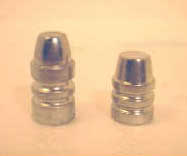 |
|
Early semi-wadcutters:
The 150 grain Ideal 360271 (left) and 115 grain Ideal 358345 (right) |
|
The first bullet that we might call a SWC that
had a separate beveled groove specifically for crimping the case mouth into was
the 311316, the GC-SWC for high-velocity loads in the .32-20 rifle. In this
case, the crimp groove is probably the result of this bullet being designed for
rifle use and the need for crimped bullets in tubular magazines. This bullet
also came out shortly after 1906 with the introduction of the GC. All of the
other pistol bullets of this era that vaguely resemble SWC's have no provision
for crimping, other than the forward driving band's shoulder. This was to
change.
In 1928, Elmer Keith commissioned Lyman to make moulds
for revolver bullets that he had designed. The third in this series of Keith's
moulds was the 358429, a 173 grain bullet that he put together specifically for
heavy loads in S&W N-frame revolvers (so-called ".38/44 loads"). This was the
first .38 SWC that incorporated a beveled crimping groove (he took his
inspiration from the round-nosed 358311), and a large capacity "square-cut" lube
groove.
|
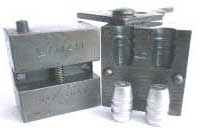 |
|
The
Ideal 311316, the first SWC suitable for handguns to have a
beveled crimp groove. |
|
Originally his .38/44 loads consisted of this long bullet seated
over 12.0 grains of DuPont #80 powder for over 1100 fps. Later, in 1933, when
2400 was introduced, he switched to using this powder and increasing the
velocity of these loads to 1200+ fps. Interestingly, as near as I can tell the
first use of the term "semi-wadcutter" didn't come about until the early 1950s,
and came into fashion with such target bullets as the Lyman 452460. Today
however, the term is most closely associated with the bullets of Elmer Keith
(and those inspired by the Keith design features), even though the term was not
originally applied to his bullets upon their introduction.
Keith made the 358429 to be the same length as his .44 SWC
(which he designed first). The weight on his .38/44 bullet came out
to 173 grains. In later years, Keith would admit that a lighter
bullet (150-160 grains) was better suited for use in the .38
Special, but he remained steadfastly faithful to his 173 grain
bullet for the .357 Magnum.
|
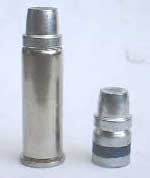 |
|
The Keith SWC, loaded in .38 Special (.38/44 loads) |
|
In my experience, this bullet needs to be
pushed hard for best accuracy, which is not surprising since, after all, EK designed it specifically
to be pushed hard. Should one desire to re-visit Keith's .38/44 Heavy Duty
loads, this bullet can be loaded over 12.0 grains of 2400 in a .38 Special case
for approximately 1200 fps (this load should only be fired in N-frame .38s, or
.357 Magnum revolvers). The most accurate .357 Magnum load I've fired using this
bullet is powered by 14.5 grains of 4227 for about 1250 fps.
The 1930s were a fertile time in terms of .38 bullet design; catalyzed
by the .38/44 loads of Elmer Keith, and later by the introduction of the .357
Magnum in 1935. However, the nose on the 358429 was too long to be seated and
crimped in the crimp groove when loaded into .357 Magnum cases -- it stuck out
in front of the S&W .357 Magnum's cylinder and prevented rotation. Phil Sharpe
sat down with George Hensley (this was shortly before George teamed up with
James Gibbs) and took Keith's design and shrunk it to 5/6 its size.
Thus was born the Hensley's #51; this was the original .357 Magnum
bullet. Loaded on top of 14.0 grains of 2400, the H&G #51 tops off a
superb .357 Magnum load.
|
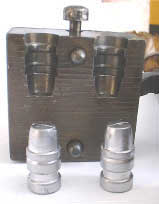 |
|
The 160 grain Hensley # 51 ("Sharpe solid"), the original .357 Magnum
bullet. |
|
Now it's not that Hensley didn't have similar bullets
available that could have been loaded into these cartridges, it's
just that they didn't have the full compliment of features that
Keith and Sharpe wanted in their bullets. For example, there's
Hensley's design #48, another 158 grain .38 SWC. But this one did
not have a beveled crimp groove and the lube grooves were notably
smaller (and remember what a reputation the .357 Magnum had for
leading in the early days, more lube was definitely viewed as an
important feature!).
The level of performance that the roaring new Magnum provided had
lots of makers supplying moulds for similar bullets.
|
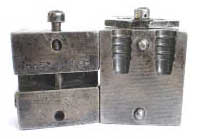 |
|
The H&G # 48 158 grain SWC (no beveled crimping groove) |
|
For example, in the late 1930s Cramer cataloged
their #12 and #26 designs. Both of these bullets are similar to H&G #51,
differing primarily in the location of their lube grooves. The nose on 156 grain
Cramer #12 is midway in length between the Keith 358429 and the H&G #51 (#12 is
similar to the SAECO #382 that would come along later, and since SAECO bought
out Cramer in 1951 this is a likely pedigree for this design). The 153 grain
Cramer #26 has a similar length nose to the H&G #51 In fact, the Cramer #26 is
basically identical to the original Lyman 358477 (which would come later, in the
1950s), with a fatter base band.
Ideal was not just sitting on their hands while these other
companies were bringing out their new .38 SWC's. The first bullet that Lyman
designed explicitly for the .357 Magnum is the Ideal 357443, perhaps the most
enigmatic member of the .38 SWC family.
|
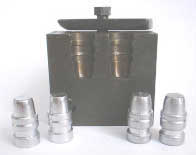 |
|
Photo of the Cramer # 26 (two bullets on left), Cramer # 12 (mould,
center) and the H&G #51 (two bullets on right) for comparison. |
|
Designed for both the .38 Special and the .357
Magnum, it was listed as early as Ideal Handbook #32 (1936), but
interestingly not in the regular line of moulds, but rather farther back in the
specialty mould listing.
This unique 160 grain bullet has 3 grease grooves and a
miniscule crimp groove in the middle of the front driving band. I suspect that
it was most commonly crimped using the top grease groove, only filling the
bottom 2 grease grooves with lube, as that dinky crimp groove is virtually
useless. The 357443 stayed in the shadows for its entire production life, being
quietly dropped from the catalog in the 1960s.
Starting in Ideal Handbook #33 (published in 1939), Lyman touted
the 160 grain plain-based 357446 as
"the standard bullet for the Magnum", and
continued to promote it as such for many years. This bullet is similar to the
H&G #48, except that the forward lube groove had been converted to a beveled
crimp groove. It also represents a natural evolution of the homely 357443 -- the
upper grease groove converted to a beveled crimp groove, the miniscule
crimp groove eliminated, the meplat/ogive filled out,
|
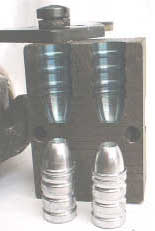 |
|
The Lyman/Ideal 357443 (note the unusual crimping groove in the
forward driving band). |
|
|
the base band fattened up slightly, with a bullet nose short
enough to function in the S&W .357 Magnum. While the 357443 wallowed in
obscurity, the handsome 357446 was a well-received and popular bullet for the
.357 Magnum. It served equally well in the .38 Special. In the late 1930s,
between the H&G, Cramer and Ideal designs, the shape, weight and function of the
preferred form of the .38 SWC was coming into focus.
The GC was introduced for various rifle calibers in 1906 by John
Barlow (the head honcho of Ideal). Pistol shooters had noticed the
advantages of the GC for high velocity .32-20 and .44-40 revolver loads,
so it's no surprise that when the spectacular velocities of the .357
Magnum were reported (1500-1600 fps), shooters naturally started to think
about adding a GC to bullets for the magnum.
|
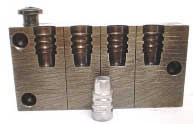 |
|
"The Standard Bullet for the .357 Magnum" for many years, the
Lyman/Ideal 358446. |
|
As near as I can tell, the first GC .38 SWC's
were the Cramer #13 and #14 (cataloged in 1939). These bullets are very similar
to the more familiar 358156 GC-SWC that we have today. The two Cramer bullets
were designed by Ross Sernow of Los Angeles, and had 2 crimping grooves so they could
be loaded and crimped to .357 Magnum OAL in .38 Special cases (.357 Magnum brass
was hard to come by in those days so shooters would load up .357 Magnum loads
with .38 brass and seat these bullets long and crimp in the bottom crimp
groove). The #13 was a 158 grain bullet that was "specially adapted to hunting"
(although it was not explicitly referred to as a hollow point in the catalog),
and the #14 was listed as a 169 grain "solid point version of #13" (alloy
unspecified).
After WW II, Ray Thompson designed a series of GC-SWC's for Lyman
in the early 1950s. The 160 grain gas-checked Lyman/Ideal 358156 was
specifically designed for the .357 Magnum and was similar to the Cramer designs
just discussed, right down to the dual crimping groove concept. The Thompson
358156 was also quite reminiscent of the old 358446, ("the standard bullet for
the Magnum") with the addition of a GC and a second crimping groove. The 358156
has spent the last 50 years as what is likely the most popular cast bullet for
the .357 Magnum, and I see no reason for that to change any time soon. It is a
superbly accurate bullet. My favorite load for this bullet in the .357 Magnum is
14.0 grains of 2400 for about 1350 fps (or 1750 fps from a lever-gun). Every
.357 Magnum that I have owned has shot this load very well.
The mid-1950s were another fertile period for the .38 SWC with the
introduction of the K-framed S&W Combat Magnum and the Ruger .357 Blackhawk.
Velocity was the selling feature of the cartridge and Lyman chose to capitalize
on that feature, while simultaneously capturing those features that Keith and
Sharpe had espoused in their designs, with the 150 grain 358477 (cataloged in
1957).
With this bullet it was easy to achieve 1500+ fps from the
.357 Magnum and 1000 fps from a .38 Special, and do both with superb accuracy
and no leading.
For my money, the original 150 grain 358477 is the finest .38
Special bullet ever designed. Loaded over 5.4 grains of Unique, it generates 982
fps from a 6" K-38 Masterpiece with exceptional accuracy.
Gordon Boser was an active handloader and wildcatter of the
1930s, '40s and '50s. He also designed some very interesting bullets. Basically,
the Boser SWC's (Lyman/Ideal 357453, 401452, and 429360)
were similar to the Keith SWC's, except that they had rounded grease grooves, the forward driving band was
smaller than the back two driving bands, and the ogive was straight instead of
radiused. It's not uncommon to hear the uninitiated refer to these Boser bullets as "Keith SWC's" but to do
so is to ignore the contributions of both men. The Boser .38 SWC (Lyman/Ideal
358453) weighs about 150 grains. The straight ogive SWC was resurrected by Lee
in the 1970s.
|
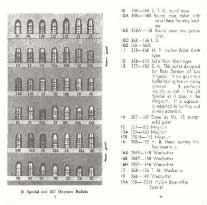 |
|
A
portion of the Cramer catalog (circa 1939); of particular interest
are the GC-SWC's #13 and #14 (scan taken from the excellent
reference resource "Castpics Research and Development" |
|
http://www.castpics.net/research.htm) |
|
Jim Harvey brought an interesting twist to the .38 SWC
concept in the mid 1950s with this "Harvey Pro-Tex Bore" line of bullets. These
bullets were designed without lube or crimp grooves and were cast through the
hole in a zinc washer, permanently imbedding the washer into the bullet.
Not having to size and lube these bullets was a selling
feature. The hard zinc washer allowed soft lead alloys to be used to
promote expansion. Extravagant claims were made about "the solid
lubricating ability of zinc", and how this lead to unprecedented
velocities, etc. Some pretty eye-popping velocities were reported, but top
accuracy was generally limited to moderate velocity loads.
|
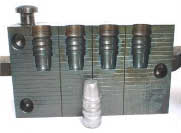 |
|
The Lyman 358156
GC-SWC; probably the most popular cast bullet ever for the
.357 Magnum |
|
Lachmiller was an active player in the
bullet mould field in the 1950s, and like most other mould makers they had a 158
grain SWC for the .38 Special and .357 Magnum.
This bullet, perhaps best of all the moulds discussed
here, captures the design features that Keith and Sharpe promoted -- 3 full-size
driving bands, a full-size flat-bottomed grease groove, a beveled crimp groove
and a functional ogive/meplat that would work in all guns.
This is an excellent bullet and one of my personal favorites.
Lachmiller was bought out by RCBS in the late 1970s.
|
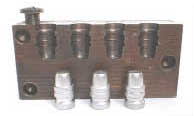 |
|
The 150 grain Lyman 358477 SWC; a fine bullet for both .38 Special
and .357 Magnum. |
|
Ohaus started making bullet moulds in 1972 and later that
decade RCBS bought them out and took over mould production. These moulds
are well thought-out derivatives of proven designs. In terms of .38
SWC's, RCBS makes 2 particularly well designed moulds, the 150 PB
SWC and the 158 grain GC-SWC.
|
 |
|
Gordon Boser's SWC design. |
|
The GC 158 is very similar to the 358156
(having a somewhat larger grease groove and lacking the second crimp groove),
and like the .358156, is a superb all-round .357 Magnum bullet.
Lee started making bullet moulds in 1973, and not
surprisingly, they also included various .38 SWC's in their line.
The first bullet mould I bought, when I started casting, was a
6-cavity Lee .38 150 SWC. I used that mould to make a lot of
bullets. Lee not only offers PB and GC designs, but also came out
with their novel tumble-lube (TL) designs. Their affordable 6 cavity
moulds allow a budding young caster on a limited budget to make a
pile of bullets in a hurry, but in general, their lube grooves are
too shallow for my taste.
|
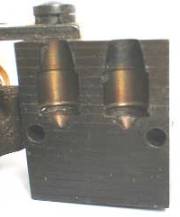 |
|
The Lyman 357500 Harvey Pro-Tex Bore
SWC mould (the slot at the base of the bullet is where the zinc
washer fits into the mould prior to pouring the molten alloy into
the cavity; the conical rivet below that is what holds the washer in
place). |
|
In the late 1980s, a new handgun game had come to
national prominence and Lyman brought out its 215 grain GC-SWC
(#358627) to address the silhouette market. This bullet is basically
the Keith SWC with a GC shank added onto the base and an extra crimp
groove added up front. While this husky bullet shoots fine in both
the .38 Special (800 fps) and the .357 Magnum (1100 fps), it was
really designed for the .357 Maximum. 1400+ fps is no problem with
this heavyweight from a .357 Maximum, making this the hardest
hitting member of the .38 SWC clan.
Bevel bases are popular in cast bullets designed for
commercial production. This is due to the fact that the BB bullet releases
more readily from the casting machine moulds used by these outfits, and
therefore production rates are higher when using BB moulds (there's no
significant difference for the home caster).
|
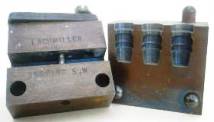 |
|
Lachmiller 3-cavity 358 158 SWC mould. |
|
In addition, the commercial caster wants
to provide a product that is going to generate the fewest number of complaints,
and well to be honest, there are some handloaders who are a little rough during load assembly, and if
the BB bullet slips into the case more easily and with less damage, then those
customers aren't going to whine as much.
However, in some guns, BB bullets can
lead to increased leading in the forcing cone area, as the throat/bullet seal is
broken while there is lots of exposed lead in the cylinder gap (this problem is
most commonly encountered in guns with a large cylinder gap). The bottom line is
that, as far as the shooter is concerned, beveled bases on cast bullets are
|
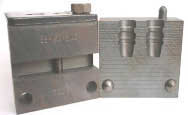 |
|
The RCBS 150 SWC, an excellent
bullet for both .38 Special and .357 Magnum. |
|
kinda
like earrings on professional football players, some folks may think
they're fashionable, but they provide nothing in terms of actual performance.
|
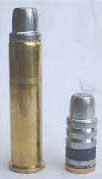 |
|
Lyman 358627 SWC loaded in .357 Maximum. |
|
There have been a
number of other designs with long noses (e.g. the H&G #73), small meplats, or
minor variations on these designs. In an effort to sharpen the focus of this
discussion, I will draw the line here.
The design elements espoused by Keith and Sharpe (full diameter
forward driving band, beveled crimp groove, large grease groove, moderately
large meplat and radiused ogive) are just as valuable today as they were back in
the 1930s. Which of these bullets best capture these features in a form most
usable in the .38 Special and .357 Magnum cartridges? That is a question of
weight, bearing surface, balance and nose length. All of these bullets have
given me fine accuracy when launched from properly assembled, well-balanced
loads. OK, so which of these .38 SWC's provide the best combination of velocity
and accuracy from the .38 Special and the .357 Magnum? For somebody who is just
starting out and may not have the connections to find moulds that were made 50+
years ago, what is currently available and what would be their best choice?
Having fired many, many thousands of these bullets, my votes fall thusly:
Best SWC for the .38 Special
Putting a GC on .38 Special bullet is kinda like putting a frilly lace
dress on John Wayne -- it just doesn't belong there! As mentioned above, my
personal favorite bullet for the .38 Special is the original 150 grain version
of the Lyman 358477. Any number of good loads will generate 950 fps with this
bullet, and do so quite accurately, but my favorite is 5.4 grains of Unique. As
far as what is available today, the RCBS 38 150 SWC (they call it a "Keith" but
it's doubtful that Elmer actually designed it) is an excellent mould and gets my
vote for the best bullet currently available for the .38 Special. The lighter
weight of these two bullets allows the sixgunner to get optimum performance out
of a .38 Special revolver.
Best SWC for the .357 Magnum
The higher pressures and higher velocities of the .357 Magnum
make a GC much more at home in this cartridge. While GC are by no means
required for this level of ballistic performance, they can make a
contribution and fit in nicely here. The Lyman 358156 is probably the most
popular cast bullet of all time for the .357 Magnum, and is certainly one
of my own personal favorites. The very similar RCBS 38 158 GC-SWC serves
with equal distinction, it just doesn't have as long, or as colorful, a
history behind it. Both of these bullets are currently available for the
new caster just starting out. I also shoot a number of plain-based cast
bullets in my .357s, my favorites being the H&G #51 (H&G moulds are
currently available through Ballisti-Cast), the Lachmiller and Cramer
SWC's; excellent .357 bullets all. For all of these bullets, my preferred powder
charge is 14.0 grains of 2400.
Best .38 SWC All-round
As an all-round cast bullet for both .38 Special and .357 Magnum, my
own personal choice would be for a plain-based bullet of 158-160 grains, with
the driving bands as close to one another in size as possible, with a
flat-bottomed grease groove, and a beveled crimp groove. These features are
captured in the 160 grain H&G #51, the Lachmiller 38 158 SWC, and the Cramer
#12.
|
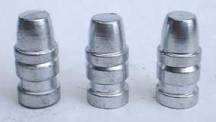 |
|
Best All-round. the H&G # 51, the
Lachmiller 38-158 SWC, and the Cramer # 12. |
|
|
 |
|
SAECO # 382 150 Grain PB. |
|
All of these bullets perform beautifully in both the .38
Special and the .357 Magnum. Currently available moulds in this class are the
H&G #51, which is available through Ballisti-Cast, and the SAECO #382 (which, as
discussed
earlier, can
trace its heritage to the Cramer line). All of these bullets are versatile,
accurate and deadly.
The .38 SWC was born at the dawn of the 20th century.
Elmer Keith took some of the ideas captured in some of the early target bullets
and incorporated a beveled crimping groove and a larger, "square-cut" grease
groove.
Phil Sharpe shortened Keith's design to
make it function in the original N-frame .357 Magnum. Others, like Ray Thompson
and Gordon Boser, added their touch to this
basic design, massaging it slightly for each successive generation of .38
shooters. As a result of these men's efforts, the .38 SWC is a refined,
versatile and highly useful bullet design. If the value of a bullet can be
judged based upon the gross tonnage of that bullet design sent downrange each
year, then the .38 SWC is clearly one of the most valuable handgun bullets of
all time!